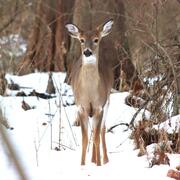Terrestrial Mammals
Terrestrial Mammals
Filter Total Items: 69
Terrestrial Mammal Research
Understanding the population dynamics, predator/prey relationships and habitat ecology of terrestrial mammals, such as caribou and muskoxen, is critical for the management of these species and their habitats in Alaska.
Key Values of a Century of EESC Science
The USGS Eastern Ecological Science Center (EESC) is rooted in a proud tradition of service to the nation—advancing science that informs the conservation and management of fish, wildlife, and habitats across the eastern United States and beyond. Our mission is clear: deliver reliable, partner-driven science that supports natural resource decisions today, while ensuring these resources remain...
EESC Makes an Impact: Preserving our Hunting Resources
Hunting is an economic engine for the U.S. and responsible management of these resources directly supports 45.2 billion dollars spent by hunters annually. Conservation and management of hunting resources also contributes substantially to the 394.8 billion dollars spent on all wildlife-related recreation. Hunting traditions are an integral component of our American heritage, with 14.4 million...
Research to support conservation of America’s national mammal, the bison
Once numbering in the tens of millions, plains bison ( Bison bison bison) were nearly driven to extinction with only a few hundred individuals remaining by the late 19th century. Plains bison have since recovered to approximately 20,000 animals managed in conservation herds throughout North America, yet substantial challenges to their recovery remain. The Department of the Interior (DOI) stewards...
Bison Conservation
USGS science in support of the Department of the Interior's Bison Conservation Initiative.
North American Bat Monitoring Program (NABat)
Bats are essential contributing members of healthy, functioning ecosystems. They perform numerous ecosystem services like insect pest control and plant pollination, and provide enormous economic benefits through ecotourism, medical research, and novel biotechnologies. North American bats face unprecedented threats including habitat loss and fragmentation, white-nose syndrome, and wind energy...
Counting America’s Wild Horses and Burros: Better Estimates for Population Management
The Wild Free-Roaming Horses and Burros Act of 1971, as amended, states that, "It is the policy of Congress that wild free-roaming horses and burros shall be protected from capture, branding, harassment, or death; and to accomplish this they are to be considered in the area where presently found, as an integral part of the natural system of the public lands (PL 92-195, Sec. 1331, Congressional...
Tracking and Modeling the Population of the Louisiana Black Bear Using “BearTRAK”
"BearTrak" is an app that provides a central repository for Louisiana black bear tracking data, allowing managers to access information more quickly and reliably. USGS science was used in the decision to delist the species from the Endangered Species Act in 2016. Louisiana Department of Wildlife and Fisheries continues to monitor the Louisiana black bear population.
Mapping wild horse densities across broad landscapes of the Western United States
Researchers at USGS are using historical wild horse survey and monitoring records to conduct a study of horse density across sagebrush ecosystems of the western United States. Researchers will develop generalized density maps for the species that will enhance concurrent evaluations into the ecological effects of wild horse populations.
Health and Energetics of Polar Bears
The warming climate has the potential to drive significant changes in the health and energetics of Arctic fauna, particularly those dependent on sea ice habitats like polar bears. An animal’s health and energetic state reflects the interaction between its behavioral choices and the environment. Because of this, measuring changes in health and energetics has potential for revealing important...
Bighorn Sheep and Mountain Goat Research in Western National Park Units
Mountain goat and bighorn sheep are iconic symbols of many national lands in the West. Both species have limited distributions that can be difficult to observe and face multiple stressors including disease, increasing recreation in remote areas, and shifting weather regimes that influence their forage and thermoregulation. As species with relatively small population sizes, understanding...
Conservation Genetics of the Hawaiian Hoary Bat
The Hawaiian Hoary Bat ( Lasiurus semotus) or ʻōpeʻapeʻa is the only extant land mammal native to the Hawaiian archipelago and is listed as endangered due to apparent population declines, and a lack of knowledge concerning its distribution, abundance, and habitat needs. This study is designed to apply molecular techniques to document demographic information, assess genetic variability, describe...













